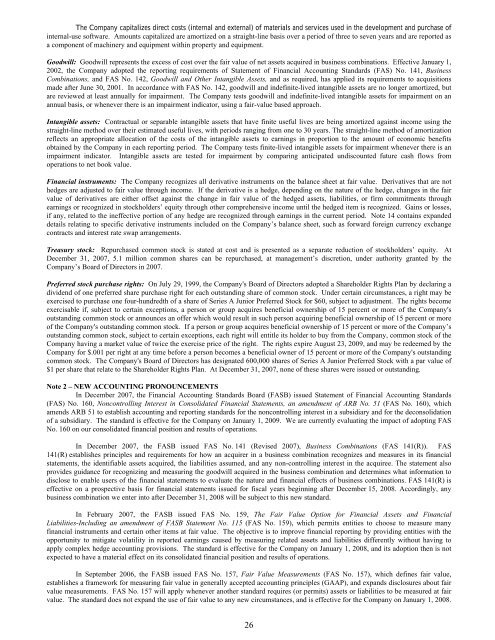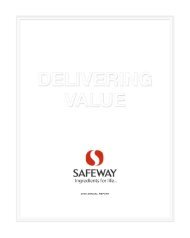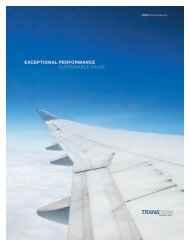Bemis Company 2007 Annual Report - IR Solutions
Bemis Company 2007 Annual Report - IR Solutions
Bemis Company 2007 Annual Report - IR Solutions
Create successful ePaper yourself
Turn your PDF publications into a flip-book with our unique Google optimized e-Paper software.
The <strong>Company</strong> capitalizes direct costs (internal and external) of materials and services used in the development and purchase of<br />
internal-use software. Amounts capitalized are amortized on a straight-line basis over a period of three to seven years and are reported as<br />
a component of machinery and equipment within property and equipment.<br />
Goodwill: Goodwill represents the excess of cost over the fair value of net assets acquired in business combinations. Effective January 1,<br />
2002, the <strong>Company</strong> adopted the reporting requirements of Statement of Financial Accounting Standards (FAS) No. 141, Business<br />
Combinations, and FAS No. 142, Goodwill and Other Intangible Assets, and as required, has applied its requirements to acquisitions<br />
made after June 30, 2001. In accordance with FAS No. 142, goodwill and indefinite-lived intangible assets are no longer amortized, but<br />
are reviewed at least annually for impairment. The <strong>Company</strong> tests goodwill and indefinite-lived intangible assets for impairment on an<br />
annual basis, or whenever there is an impairment indicator, using a fair-value based approach.<br />
Intangible assets: Contractual or separable intangible assets that have finite useful lives are being amortized against income using the<br />
straight-line method over their estimated useful lives, with periods ranging from one to 30 years. The straight-line method of amortization<br />
reflects an appropriate allocation of the costs of the intangible assets to earnings in proportion to the amount of economic benefits<br />
obtained by the <strong>Company</strong> in each reporting period. The <strong>Company</strong> tests finite-lived intangible assets for impairment whenever there is an<br />
impairment indicator. Intangible assets are tested for impairment by comparing anticipated undiscounted future cash flows from<br />
operations to net book value.<br />
Financial instruments: The <strong>Company</strong> recognizes all derivative instruments on the balance sheet at fair value. Derivatives that are not<br />
hedges are adjusted to fair value through income. If the derivative is a hedge, depending on the nature of the hedge, changes in the fair<br />
value of derivatives are either offset against the change in fair value of the hedged assets, liabilities, or firm commitments through<br />
earnings or recognized in stockholders’ equity through other comprehensive income until the hedged item is recognized. Gains or losses,<br />
if any, related to the ineffective portion of any hedge are recognized through earnings in the current period. Note 14 contains expanded<br />
details relating to specific derivative instruments included on the <strong>Company</strong>’s balance sheet, such as forward foreign currency exchange<br />
contracts and interest rate swap arrangements.<br />
Treasury stock: Repurchased common stock is stated at cost and is presented as a separate reduction of stockholders’ equity. At<br />
December 31, <strong>2007</strong>, 5.1 million common shares can be repurchased, at management’s discretion, under authority granted by the<br />
<strong>Company</strong>’s Board of Directors in <strong>2007</strong>.<br />
Preferred stock purchase rights: On July 29, 1999, the <strong>Company</strong>'s Board of Directors adopted a Shareholder Rights Plan by declaring a<br />
dividend of one preferred share purchase right for each outstanding share of common stock. Under certain circumstances, a right may be<br />
exercised to purchase one four-hundredth of a share of Series A Junior Preferred Stock for $60, subject to adjustment. The rights become<br />
exercisable if, subject to certain exceptions, a person or group acquires beneficial ownership of 15 percent or more of the <strong>Company</strong>'s<br />
outstanding common stock or announces an offer which would result in such person acquiring beneficial ownership of 15 percent or more<br />
of the <strong>Company</strong>'s outstanding common stock. If a person or group acquires beneficial ownership of 15 percent or more of the <strong>Company</strong>’s<br />
outstanding common stock, subject to certain exceptions, each right will entitle its holder to buy from the <strong>Company</strong>, common stock of the<br />
<strong>Company</strong> having a market value of twice the exercise price of the right. The rights expire August 23, 2009, and may be redeemed by the<br />
<strong>Company</strong> for $.001 per right at any time before a person becomes a beneficial owner of 15 percent or more of the <strong>Company</strong>'s outstanding<br />
common stock. The <strong>Company</strong>'s Board of Directors has designated 600,000 shares of Series A Junior Preferred Stock with a par value of<br />
$1 per share that relate to the Shareholder Rights Plan. At December 31, <strong>2007</strong>, none of these shares were issued or outstanding.<br />
Note 2 – NEW ACCOUNTING PRONOUNCEMENTS<br />
In December <strong>2007</strong>, the Financial Accounting Standards Board (FASB) issued Statement of Financial Accounting Standards<br />
(FAS) No. 160, Noncontrolling Interest in Consolidated Financial Statements, an amendment of ARB No. 51 (FAS No. 160), which<br />
amends ARB 51 to establish accounting and reporting standards for the noncontrolling interest in a subsidiary and for the deconsolidation<br />
of a subsidiary. The standard is effective for the <strong>Company</strong> on January 1, 2009. We are currently evaluating the impact of adopting FAS<br />
No. 160 on our consolidated financial position and results of operations.<br />
In December <strong>2007</strong>, the FASB issued FAS No. 141 (Revised <strong>2007</strong>), Business Combinations (FAS 141(R)). FAS<br />
141(R) establishes principles and requirements for how an acquirer in a business combination recognizes and measures in its financial<br />
statements, the identifiable assets acquired, the liabilities assumed, and any non-controlling interest in the acquiree. The statement also<br />
provides guidance for recognizing and measuring the goodwill acquired in the business combination and determines what information to<br />
disclose to enable users of the financial statements to evaluate the nature and financial effects of business combinations. FAS 141(R) is<br />
effective on a prospective basis for financial statements issued for fiscal years beginning after December 15, 2008. Accordingly, any<br />
business combination we enter into after December 31, 2008 will be subject to this new standard.<br />
In February <strong>2007</strong>, the FASB issued FAS No. 159, The Fair Value Option for Financial Assets and Financial<br />
Liabilities-Including an amendment of FASB Statement No. 115 (FAS No. 159), which permits entities to choose to measure many<br />
financial instruments and certain other items at fair value. The objective is to improve financial reporting by providing entities with the<br />
opportunity to mitigate volatility in reported earnings caused by measuring related assets and liabilities differently without having to<br />
apply complex hedge accounting provisions. The standard is effective for the <strong>Company</strong> on January 1, 2008, and its adoption then is not<br />
expected to have a material effect on its consolidated financial position and results of operations.<br />
In September 2006, the FASB issued FAS No. 157, Fair Value Measurements (FAS No. 157), which defines fair value,<br />
establishes a framework for measuring fair value in generally accepted accounting principles (GAAP), and expands disclosures about fair<br />
value measurements. FAS No. 157 will apply whenever another standard requires (or permits) assets or liabilities to be measured at fair<br />
value. The standard does not expand the use of fair value to any new circumstances, and is effective for the <strong>Company</strong> on January 1, 2008.<br />
26







